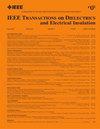热激励条件下基于PDC试验的中压电力电缆接头湿性判别方法
IF 3.1
3区 工程技术
Q2 ENGINEERING, ELECTRICAL & ELECTRONIC
IEEE Transactions on Dielectrics and Electrical Insulation
Pub Date : 2024-10-30
DOI:10.1109/TDEI.2024.3487957
引用次数: 0
摘要
湿气渗入电力电缆接头,加速电缆绝缘劣化,最终导致电缆故障和停电。判断环境水分是否渗透绝缘界面,判断湿气状态,是电缆运行、维护和管理中的一项重要任务。为此,提出了一种基于热刺激下的极化和退极化电流(PDC)测试的湿度判别方法。首先,提出了PDC测试法检测电缆接头含水率的工作原理。随后,基于热刺激下的PDC测试,对电缆接头的湿性判别原理进行了详细的描述。分析表明,热刺激可以改变水的相态和交联聚乙烯(XLPE)与硅橡胶(SiR)之间的界面接触状态,降低电缆的导电电流。此外,采用有限元模拟确定了热刺激方法的参数。最后,实验结果验证了该方法在准确识别电缆接头湿气缺陷方面的有效性。本文章由计算机程序翻译,如有差异,请以英文原文为准。
A Dampness Discrimination Method for MV Power Cable Joints Based on PDC Testing Under Thermal Excitation Conditions
The penetration of moisture into power cable joints accelerates cable insulation degradation, ultimately leading to cable breakdowns and power outages. The determination of whether environmental moisture has penetrated an insulation interface and the discrimination of dampness status are, thus, significant tasks in cable operation, maintenance, and management. Therefore, a dampness discrimination method based on polarization and depolarization current (PDC) testing under thermal stimulation is presented here. Initially, a working principle of the PDC testing method for detecting moisture in cable joints is developed. Subsequently, a thorough description of the principle of dampness discrimination in cable joints is provided based on PDC testing under thermal stimulation. This analysis reveals that thermal stimulation may alter the phase state of water and the interface contact state between cross-linked polyethylene (XLPE) and silicone rubber (SiR), decreasing the conducting current of the cable. In addition, finite element simulations are employed to determine the parameters for the thermal stimulation methods. Finally, experimental results confirm the effectiveness of the proposed method in accurately identifying dampness defects in cable joints.
求助全文
通过发布文献求助,成功后即可免费获取论文全文。
去求助
来源期刊
CiteScore
6.00
自引率
22.60%
发文量
309
审稿时长
5.2 months
期刊介绍:
Topics that are concerned with dielectric phenomena and measurements, with development and characterization of gaseous, vacuum, liquid and solid electrical insulating materials and systems; and with utilization of these materials in circuits and systems under condition of use.

 求助内容:
求助内容: 应助结果提醒方式:
应助结果提醒方式:


